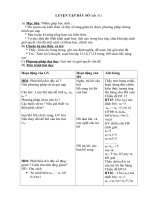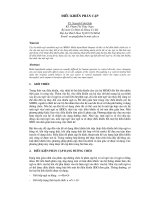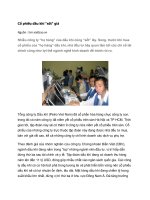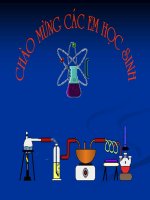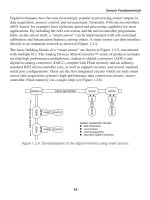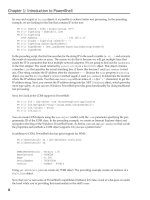Tài liệu Industrial Machinery Repair P2 pptx
Bạn đang xem bản rút gọn của tài liệu. Xem và tải ngay bản đầy đủ của tài liệu tại đây (51.6 KB, 10 trang )
24 Fundamental Requirements of Effective Preventive/Predictive Maintenance
production supervisor in charge of the equipment to establish a specific
time for the preventive task.
5 The craftsperson should make every effort to do the job according to
schedule.
6 As soon as the work is complete, the maintenance person should notify
the production supervisor so that the equipment may be put back into
use.
Overdue work should betracked and brought up-to-date. Preventive mainte-
nance scheduling should make sure that the interval is maintained between
preventive actions. For example, if a preventive task for May is done on the
thirtieth of the month, the next monthly task should be done during the
last week of June. It is foolish to do a preventive maintenance task on May
30th and another June 1st, just to be able to say one was done each month.
In the case of preventive maintenance, the important thing is not the score
but how the game was played.
Assuring Completion
A formal record is desirable for every inspection and preventive maintenance
job. If the work is at all detailed, a checklist should be used. The completed
checklist should be returned to the maintenance office on completion of
the work. Any open preventive maintenance work orders should be kept
on report until the supervisor has checked the results for quality assurance
and signed off approval. Modern computer technology with handheld com-
puters and pen-based electronic assistants permits paperless checklists and
verification. In many situations, a paper work order form is still the most
practical media for the field technician. The collected data should then be
entered into a computer system for tracking.
Record Keeping
The foundation records for preventive maintenance are the equipment files.
In a small operation with less than 200 pieces of complex equipment, the
records can easily be maintained on paper. The equipment records provide
information for purposes other than preventive maintenance. The essential
items include:
●
Equipment identification number;
●
Equipment name;
Fundamental Requirements of Effective Preventive/Predictive Maintenance 25
●
Equipment product/group/class;
●
Location;
●
Use meter reading;
●
PM interval(s)
●
Use per day;
●
Last PM due;
●
Next PM due;
●
Cycle time for PM;
●
Crafts required, number of persons, and time for each;
●
Parts required.
Back to Basics
Obviously, effective maintenance management requires much more than
these fundamental tasks. However, these basic tasks must be the foundation
of every successful maintenance program. The addition of other tools, such
as CMMS, predictive maintenance, etc., cannot replace them.
3 Maintenance Skills Assessment
Introduction
A maintenance skills assessment is a valuable tool in determining the
strengths and weaknesses of an individual or a given group of employ-
ees in order to design a high-impact training program that targets those
documented needs. Maintenance personnel have often found it difficult to
upgrade their technical skills because much that is available is redundant
or does not take their current skill level into consideration. An assessment
is designed to eliminate those problems by facilitating the construction of
customized training paths for either individuals or the group based upon
demonstrated existing knowledge and skills. When used in conjunction with
a job task analysis, a gap analysis can be performed to determine both what
skills are needed in order to perform the job effectively and what skills those
in the workforce presently have.
Definition of a Skills Assessment
A maintenance skills assessment consists of a series of written tests, per-
formance exercises, and identification activities selected from a listing of
mechanical basic skill areas. In this chapter maintenance mechanics will be
able to assess their maintenance knowledge only because skills can only be
assessed through a hands-on assessment. However, the knowledge assess-
ment is the prerequisite for all skills. The written assessment in this chapter
is written at an eighth-grade level (maintenance mechanics, in most indus-
tries, must be able to read proficiently at least at the 12-year twelfth-grade
level). A maintenance person without the knowledge required for a specific
skill can be assured mistakes will be made in mechanical judgment and abil-
ity and thus will cause equipment failures. This knowledge assessment will
not cover all skill areas covered in this book but will cover chapters that are
considered the mechanical basics.
Maintenance Skills Assessment 27
Knowledge Assessment
This knowledge assessment is directed to the following skills. The answers
will be provided in Appendix A at the end of the book. A minimum score
of 90% in each skill area should be considered acceptable in most cases.
However, some skill areas could require a higher score if the risk of failure
due to a knowledge gap is high. In all areas of maintenance, a maintenance
person must know the risk.
The knowledge assessment will be performed in the following skills areas:
●
Safety
●
Lubrication
●
Bearings
●
Chain Drives
●
Belt Drives
●
Hydraulics
●
Couplings
Knowledge Assessment
The assessment is multiple choice. Select the best answer. Do not look at
the answers until you have answered all the questions.
Knowledge Area: Safety
1 What term is used to describe places where moving parts meet or come
near each other?
A. Guard
B. Closer
28 Maintenance Skills Assessment
C. Pinch points
D. Assembly point
2 What is another name for back-and-forth motion?
A. Reciprocating motion
B. Away
C. Advancing lateral
D. None of the above
3 What is the term “point of operation?”
A. The section of the process where the machine centers meet
B. The main focus of process
C. The place where the raw material or work-piece is processed by a
machine
D. A point where operators cannot see
4 If a bench grinder is equipped with safety guards, is it necessary for you
to wear personal protective equipment?
A. Yes
B. No
5 What type of machine guard limits the operator’s access to the danger
zone?
A. Safety chain
B. E-stop
C. A barrier guard
D. None of the above
6 What type of machine guard prevents access to the danger zone
altogether?
A. An enclosure guard
B. Safety chain
C. Barrier guard
D. None of the above
7 What kind of guards cannot be moved when a machine is in operation?
A. Barrier guards
B. Fixed guards
C. E-stop guards
D. None of the above
Maintenance Skills Assessment 29
8 What type of guard prevents a machine from operating when the guard
is opened or removed?
A. Barrier guard
B. Tapeless guard
C. An interlocking guard
D. None of the above
9 What type machine guard is capable of physically pulling an operator’s
hands out of the danger zone?
A. An automatic guard
B. Barrier guard
C. Restrictive guard
D. None of the above
10 When will a presence-sensing guard stop a machine?
A. When a person is located outside of the danger zone
B. When a light signals a safety alert
C. There is no such item
D. When a person or object enters the danger zone
11 What kind of controls does a machine have if the operator must remove
both hands from the danger zone in order to start the machine?
A. Hand-free controls
B. Two-hand trip controls
C. Standard controls
D. Automatic controls
12 What kinds of tools make it unnecessary for an operator to reach into
the danger zone?
A. Hand-extraction tools
B. Local guarding tools
C. Feeding and extracting tools
D. None of the above
13 Under what conditions would you remove someone else’s lock from a
lockout device?
A. When plant manager or maintenance manager approves
B. When the person that installed the lockout cannot be found after
30 minutes
C. When you think it is OK to do so safely
D. According to your plant’s lockout procedure
30 Maintenance Skills Assessment
14 What must your employer provide in addition to the appropriate PPE?
A. Training in its use
B. Safety bulletins
C. Training material and trainers
D. None of the above
15 What is your responsibility before using PPE?
A. None
B. You must inspect it
C. Locate all documents controlling it
D. You must report its condition to your supervisor
16 Why should you avoid loose-fitting clothing in the plant?
A. It can create a barrier from sharp parts
B. It can get caught in moving parts
C. It is unprofessional
D. None of the above
17 What should you do if you accidentally come in contact with a dangerous
chemical?
A. It depends on the chemical
B. Report to the safety director
C. Shower for at least 15 minutes to rinse thoroughly
D. None of the above
18 How much clearance should hard-hat webbing provide between your
head and the top of the shell?
A. Close as possible
B.
1
2
"
C. Does not matter
D. 1"
19 How can you keep dust and liquids from reaching your eyes from any
direction?
A. By wearing safety goggles
B. By wearing safety glasses
C. By wearing a face shield
D. Any of the above
Maintenance Skills Assessment 31
20 What units are used to measure noise?
A. Trebels
B. Decibels
C. Milibars
D. None of the above
Knowledge Area: Lubrication
1 A lubricant’s viscosity is rated by what type of unit?
A. SSU
B. SAE
C. ISA
D. LVU
2 A lubricant with high viscosity has a:
A. High speed.
B. High temperature.
C. High resistance to flow.
D. High resistance to breakdown.
3 A low-viscosity lubricant:
A. Provides good cushioning for machine shock loads.
B. Can flow into tight spaces for better lubrication.
C. Does not carry heat away as well as a high-viscosity lubricant.
D. Costs less than a high-viscosity lubricant.
4 What are two disadvantages of high-viscosity lubricants?
A. They are expensive and cannot be used on high-speed motors.
B. They break down quickly and are difficult to apply.
C. They do not flow well and do not carry heat away well.
D. They do not protect against abrasive action of dirt, and they break
down quickly.
5 Multiple-viscosity lubricants differ from single-viscosity lubricants
because:
A. They have special additives that extend their effective temperature
range.
B. They are best within a very narrow temperature range.
32 Maintenance Skills Assessment
C. They will never degrade under high temperatures.
D. They last longer.
6 One advantage of multiple-viscosity lubricants is that:
A. They flow better at medium range temperatures than at either
extreme.
B. They have a high bearing capacity.
C. They have a broad working temperature range.
D. They do not break down in the presence of water.
7 Which of the following is NOT a factor affecting the selection of a
lubricant?
A. Machine speed
B. Environmental humidity
C. Operating temperature
D. Environmental temperatures
8 When choosing a lubricant, you want:
A. The lubricant to stay thin at high temperatures.
B. The lubricant to thicken at low temperatures.
C. The lubricant to thin at low temperatures.
D. The lubricant to maintain effective viscosity at its highest rated
temperatures.
9 An oil cooler is used to:
A. Add heat to the oil to enable it to flow better at low temperatures.
B. Add heat to the oil to keep it from thinning at high temperatures.
C. Remove heat from the oil to prevent it from thinning at high
temperatures.
D. Remove heat from the oil to prevent it from thickening at low
temperatures.
10 What function do detergent additives in lubricants perform?
A. Keep metal surfaces clean
B. Keep the lubricant clean
C. Minimize the amount of foaming
D. All of the above
11 An anti-oxidation additive in a lubricant:
A. Controls the level of dirt.
B. Controls the amount of mixing with air.
Maintenance Skills Assessment 33
C. Controls the level of foaming.
D. Prevents the lubricant from mixing with metal particles.
12 As a mechanic, you observe that a machine bearing is extremely hot and
becoming discolored as it operates. Your conclusion is that the:
A. Lubricant is contaminated by water.
B. Bearing is about to seize.
C. Lubricant is causing acid corrosion on the bearing.
D. Bearing is not compatible with the lubricant.
13 When cooling an overheated bearing, what should you do first?
A. Wrap the bearing housing in hot, wet rags.
B. Spray cool water on the bearing.
C. Inject cool oil in the bearing.
D. Wrap the bearing housing in cool, wet rags.
14 Oil returning to the sump is visually cloudy and foaming. You conclude
that the oil is:
A. Contaminated with soot.
B. Contaminated with water.
C. Contaminated with metal particles.
D. In need of detergent additives.
15 Undesired oil misting can be reduced by:
A. Increasing the temperature of the oil.
B. Increasing the speed of the machine.
C. Increasing the viscosity of the oil.
D. Reducing the viscosity of the oil.
16 A grease cup is defined as a:
A. Cup filled with grease that screws onto a fitting.
B. Timed lubrication system controlled by a rotating cam.
C. Gravity system that forces lubricant onto or into the area needing
lubrication.
D. Fitting that applies oil in droplet form.
17 A lubricating system used in low-speed applications in which a needle
valve meters a steady rate of lubricant to a machine without recycling
the lubricant is a(n):
A. Dip lubricator.
B. Shot lubricator.
